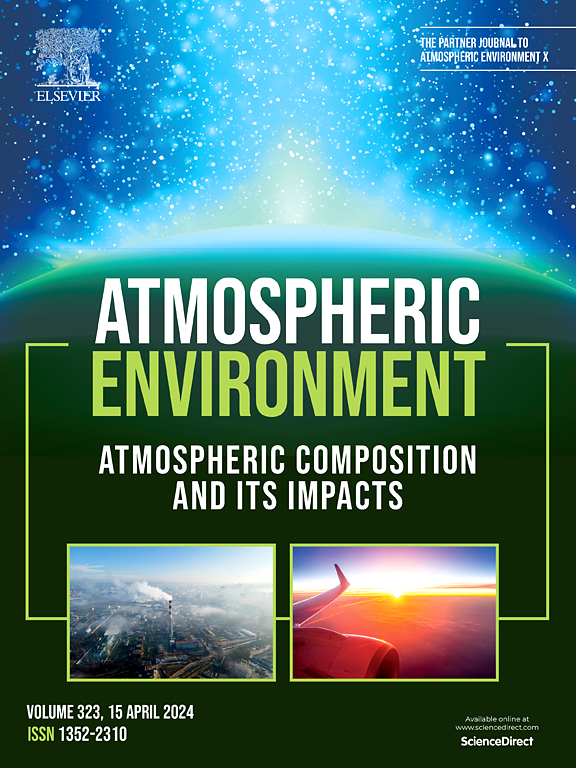Ozonolysis of prenol, a second-generation biofuel, in atmospheric simulation chambers: Temperature dependent kinetics and gas-phase products analysis
IF 4.2
2区 环境科学与生态学
Q2 ENVIRONMENTAL SCIENCES
引用次数: 0
Abstract
Prenol (3-methyl-2-buten-1-ol), a second-generation biofuel, is released in the atmosphere during its use and storage where it can react with atmospheric oxidants. In this study, the ozonolysis reaction of prenol was investigated in two atmospheric simulation chambers CHARME (CHamber for the Atmospheric Reactivity and Metrology of the Environment) and THALAMOS (Thermally Regulated Atmospheric Simulation Chamber). PTR-ToF-MS and SIFT-MS were used to monitor the concentrations of organic compounds versus time. The room temperature (293 ± 2 K) rate coefficient was determined using the relative and pseudo-first order methods. The values obtained using both methods in the two chambers were in accordance, leading to an average rate coefficient of (3.26 ± 0.33) × 10−16 cm3 molecule−1 s−1. The temperature-dependent rate coefficient of this reaction was also investigated using the relative method in the temperature range 283–353 K. The following Arrhenius expression: cm3 molecule−1 s−1 was obtained. The gas-phase oxidation products formed, at room temperature (293 ± 2 K), from this reaction were investigated using PTR-ToF-MS, SIFT-MS and GC-EI-MS analyses. Several products were identified and quantified (in %), including acetone (9 ± 2), whose formation yield was determined using a calibration standard, and acetaldehyde (30 ± 5), glycolaldehyde (30 ± 5), formaldehyde (8 ± 1), methylglyoxal (8 ± 1) and hydroxyacetone and/or methylacetate (5 ± 1) %, whose formation yields were estimated using a generic H3O+ rate coefficient for their protonation reaction. Glyoxal was also observed but not quantified. The kinetic data are compared with literature and a reaction mechanism is proposed. To our knowledge, this work is the first one presenting the mechanistic study and Arrhenius equation for the ozonolysis reaction of prenol.
大气模拟室中二代生物燃料prenol的臭氧分解:温度依赖动力学和气相产物分析
丙烯醇(3-甲基-2-丁烯-1-醇)是第二代生物燃料,在使用和储存过程中会释放到大气中,并与大气氧化剂发生反应。在本研究中,在两个大气模拟室CHARME(环境大气反应与计量室)和THALAMOS(热调节大气模拟室)中研究了prenol的臭氧分解反应。采用PTR-ToF-MS和SIFT-MS监测有机化合物浓度随时间的变化。室温(293±2k)速率系数采用相对法和拟一阶法测定。两种方法在两个实验室内得到的结果一致,平均速率系数为(3.26±0.33)× 10−16 cm3分子−1 s−1。在283 ~ 353 K的温度范围内,用相对法研究了该反应的温度依赖速率系数。得到如下Arrhenius表达式:k=(9.83±1.7)×10−16×exp(−331±53T) cm3分子−1 s−1。采用PTR-ToF-MS、SIFT-MS和GC-EI-MS分析了该反应在室温(293±2 K)下形成的气相氧化产物。几个产物被鉴定和量化(以%为单位),包括丙酮(9±2),其生成率使用校准标准确定,乙醛(30±5),乙醇醛(30±5),甲醛(8±1),甲基乙二醛(8±1)和羟丙酮和/或甲基乙酸(5±1)%,其生成率使用通用h30 +速率系数估计质子化反应。乙二醛也被观察到,但没有被量化。将动力学数据与文献进行了比较,并提出了反应机理。据我们所知,这项工作是第一次提出了苯丙醇臭氧分解反应的机理研究和Arrhenius方程。
本文章由计算机程序翻译,如有差异,请以英文原文为准。
求助全文
约1分钟内获得全文
求助全文
来源期刊

Atmospheric Environment
环境科学-环境科学
CiteScore
9.40
自引率
8.00%
发文量
458
审稿时长
53 days
期刊介绍:
Atmospheric Environment has an open access mirror journal Atmospheric Environment: X, sharing the same aims and scope, editorial team, submission system and rigorous peer review.
Atmospheric Environment is the international journal for scientists in different disciplines related to atmospheric composition and its impacts. The journal publishes scientific articles with atmospheric relevance of emissions and depositions of gaseous and particulate compounds, chemical processes and physical effects in the atmosphere, as well as impacts of the changing atmospheric composition on human health, air quality, climate change, and ecosystems.
 求助内容:
求助内容: 应助结果提醒方式:
应助结果提醒方式:


